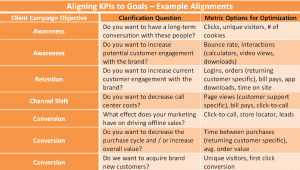 As a marketer, your goal for most campaigns is to create value for your brand’s top line by increasing things like orders and revenue. Historically, this choice was made because there was a lack of additional viable KPIs to choose from. There used to be questions like, “Did we see more revenue after we shipped out a bunch of catalogs? Were we selling three times as much in market B after we setup billboards in and out of the city center?” However, marketers didn’t have an accurate way of determining just how good their brand was doing at supporting its main goals. Sure, there were ways to “track” the performance of tactics, but they were far from perfect. How often does the customer remember its special 25-character alpha-numeric brochure code? Did he or she dial that special phone number or was it simply easy enough to dial the corporate 1-800 number and place the order?
As a marketer, your goal for most campaigns is to create value for your brand’s top line by increasing things like orders and revenue. Historically, this choice was made because there was a lack of additional viable KPIs to choose from. There used to be questions like, “Did we see more revenue after we shipped out a bunch of catalogs? Were we selling three times as much in market B after we setup billboards in and out of the city center?” However, marketers didn’t have an accurate way of determining just how good their brand was doing at supporting its main goals. Sure, there were ways to “track” the performance of tactics, but they were far from perfect. How often does the customer remember its special 25-character alpha-numeric brochure code? Did he or she dial that special phone number or was it simply easy enough to dial the corporate 1-800 number and place the order?
Start Leveraging Primary KPIs
Today, despite being in the time of pixels, cookies, DSPs, DMPs, web analytics packages, media platforms, and a whole host of third-party data providers and tools, some marketers are still stuck in thinking in the black and white views. For a company to stay in business, it needs to fundamentally support the key marketing objectives of measuring orders and revenues. With the explosion of metrics that range from basic market sizing and demand all the way to intimate details of how individual cookies are interacting with your website, marketers need to start leveraging these as primary KPIs when they make sense to do so to measure campaign success.
Also Read: Customer Data Is the Next Competitive Battleground Shaping the Future of Digital Marketing
Choosing the Right Metric
To make things even more complicated, it isn’t about selecting different metrics, but about understanding what those metrics represent given the context of what you’re trying to accomplish. The same metric may be the right KPI for campaign 1, but be completely irrelevant for campaign 2, despite them having similar overall objectives. For example, clicks may make sense as the end goal for an awareness campaign — you got someone to interact with your ad and now they are on the website and you assume they did something. Huge win, right? But what happens if the bounce rate is at 90 percent or the visitor spends less than 10 seconds on the page? Do you still feel the same way? If there are various video play opportunities, downloadable content and various tools/calculators for your prospect to interact with and that visitor didn’t use any of it, do you still think this campaign was a success?
On the other hand, what if you are simply driving awareness to your site so that you can engage users later via remarketing? In this instance, clicks may be fine to call out how many visits you’ve made to the website has seen that you can build a retargeting campaign around. You could certainly make the case that there are better metrics than clicks for this example (like cookie pool size and unique visitors), but you can see how two basic awareness campaigns would fork into two different sets of KPIs.
For additional food for thought, see the below table that lists a few of the more common marketing objectives, a list of questions, and the metrics that can be used to help answer those questions.

We can now start to see see how poor KPI selection impacts campaign management, bidding and budgeting, and marketing message. It is a snowball effect that gets bigger and bigger as it goes downhill and ends up crashing through your door. Irrelevant keywords with poor messages are prioritized over keywords that are actually driving individuals to get to know your brand. Budget is prioritized in this direction too, and the only thing you have to show for it is clicks — a metric that can be easily manipulated by bidding into first position or doing total page takeovers or using dynamic overlay display ads.
Interpreting The Metrics
There are certainly a lot more metrics out there than ever before, and the interpretation of those metrics can be drastically different depending on what audience segment you are looking at or which filter you have on or even which campaign it is being run out of. The key is to take a step back, ask the right questions, and think through what the goal/objective is and then choose the metrics that make the most sense to determine success or failure. It may still all go back to how much revenue was brought in or how many orders were placed, but you can make more informed decisions and feel confident in doing so by making sure you align the right KPIs for the job at hand.











